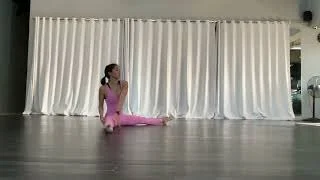Easy to remember ingredients of the loop.
For this exercise, my loop consisted of three steps - HAND, FOOT, TURN. I first tried to keep it as slow and simple as possible. One hand movement, then one foot movement, then a body turn to change position. The actions existed on their own - the hand and foot movement did not necessarily move into each other, but they were independent of each other. I slowly tried to integrate the movement - what I did with my hand (or rather, full arm), led into the foot movement, which led into the body turn. I would sometimes feel that the turn would preempt the next hand movement, and would almost stop myself from the continuous movement, to break down the loop a bit more.
I also tried to first move one body part at a time, until I would progress to two hands at a time, then two feet at a time. Another change marker was changing my body orientation - when I was in the standing positions, I felt the movements were bigger, more turns every time I would change positions, and so on. I tried to end the loop softly, still standing, but also going back to one hand and one foot movement at a time, but this time, staying in the standing position.
Describe the process. How did I choose the parts?
I wanted an easy to remember loop that had various elements that could be changed, but also stayed in its structure. I stuck to HAND, FOOT, TURN, so that could fulfill those requirements.
This is the 2nd time for me to try the loop. I also changed the music to something more meditative for my own emotions during the loop. During the first time, I actually felt I stuck to the structure well, but felt a bit like I didn’t know how to end it. It was quite abrupt. With this second try, I was able to explore a bit more intentionally with the changes thrown in, and to end with a bit of meditation and slow movement.
What felt good?
It really felt good to explore!! One of the reasons I took this course was really to find movement that was more like myself, and not just a copy of my previous teachers’ or even of my Instagram idols (they’re amazing, but I do want to find more sincerity in what I engage in and teach - not only learn things because of what is “cool” or trending in the pole world). And for a few minutes in the loop (and in other loops in this FFTT), I really did feel like this movement was my own, and not derivative. That’s also what I love about sticking to simple loops and trying not to over think the steps - I can really explore and move like myself. <3 It also felt good when I would think of one element to change (when I moved on to two hands, two feet, etc.), because I would also think of these changes as the loop went on. The movement led to more movement. The exploration started itself and I really felt like I was in some moments of Flow in these few minutes.
If there is one thing I would do differently?
I think I would try to do this for a longer period of time. When I ended the sequence, I felt I could still do a bit more, and maybe a loop with a lot of possibilities like this, would need a longer period of time for me to flesh it out as well.
I am definitely still going to try to do this loop, but with other songs with different pacing. I would also like to explore other ways to change the loop (for example, if I didn’t use one hand the whole time, and only stuck to one side of my body for the actions).
What did you learn from this experience that you could apply to your own training or teaching?
On a technical level, I think this would be a great loop to try to teach shoulderstands, or pirhouettes on the pole. I also want to keep exploring this loop as a prompt to create choreography (whether on the floor, or on the pole).

